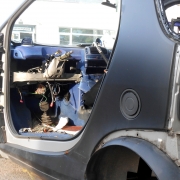E-Scrap Committee: WEEE Recycling Experiences Ripple Effect of “the Fight for Raw Materials”
Latest developments in the ever-shifting but ever-expanding world of electrical and electronic equipment recycling were debated at the BIR E-Scrap Committee webinar broadcast on November 17, with expert insights focusing on two of WEEE’s most important constituents – plastics and metals.
BIR E-Scrap Committee Chairman Dr Helmut Kolba of Germany-based Remondis Electrorecycling GmbH began by highlighting “more and more challenges” for the WEEE recycling sector, including: mounting restrictions on cross-border movements of materials; greater demand for IT equipment and other household products as a result of the COVID pandemic; and disruption to supply chains.
A major trend identified by Dr Kolba was electrical and electronic product complexity leading to “an increase in demand for more sophisticated machinery”. Providing a plastics perspective, BIR Plastics Committee representative Max Craipeau of Greencore Resources Limited in China agreed: “We see more and more international brands coming to Asia offering different types of technology to ensure that the purity coming out of the WEEE scrap is reaching 99% and above.” If processors did not use “high-end” technology such as electrostatic, near-infrared or laser spectroscopy separation, then they would not be in a position to sell their end-product at a premium to manufacturers, he said.
With rising metals prices and increased quality requirements imposed on scrap imports, “we’ve seen a lot of people investing in additional separation equipment for the non-ferrous metals”, observed fellow panelist Alton Scott Newell III of Newell Recycling Equipment in the USA. The Chairman of BIR’s Shredder Committee added that rising landfill costs in America would see a continuation of the trend towards diversion of materials.
Boosted by “sustainability pressure from the consumers”, European and US-based global brands “now want to incorporate more and more recycled content in their products”, said Mr Craipeau. As a result, many scrap plastics captured from WEEE “now sell for a premium versus virgin plastics”. This could be “quite a profitable business” that would certainly attract “more and more newcomers”, he ventured.
Since China had closed its doors to plastic scrap imports several years ago, more WEEE was being processed at source in Western countries, and Asia too was developing more local processing of locally-generated WEEE, according to Mr Craipeau. But while restrictions on transboundary movements of materials had helped fuel the trend towards increased local recycling, Mr Newell warned that closing borders had the potential to drive down material prices and undermine collections. “I hope it’s possible that world market prices will prevail for everywhere,” he said.
Forecasts suggest that WEEE will amount to around 57 million tonnes worldwide in 2021, with subsequent growth predicted at 2 million tonnes per year. While each recyclable within WEEE – be it plastic or metal – has its own distinct market, all are becoming increasingly embroiled in “the fight for raw materials”, said Dr Kolba.
Source: BIR (Brussels, November 18, 2021)







